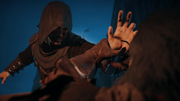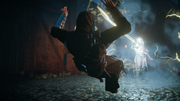mNo edit summary Tag: sourceedit |
Francesco75 (talk | contribs) (Trivia) Tag: rte-source |
||
| Line 28: | Line 28: | ||
==Trivia== |
==Trivia== |
||
*De Carneillon's robes bore similarities to the ones worn by the [[Master Assassin]]s of the [[Levantine Assassins|Levantine Brotherhood]] near the end of the 12th century. |
*De Carneillon's robes bore similarities to the ones worn by the [[Master Assassin]]s of the [[Levantine Assassins|Levantine Brotherhood]] near the end of the 12th century. |
||
| + | **Also De Carneillon's robes have differents features. During [[The Tragedy of Jacques de Molay]], he wore a red robe with strips, in the Helix database, he had a red robe with patterns and wore gloves, and Arno found a blue robe with patterns. |
||
*The [[Helix]] database mentioned de Carneillon was a friend of [[Dante Alighieri]], [[Marco Polo]], and [[Domenico Auditore]], all of whom were [[Italian Assassins]]. |
*The [[Helix]] database mentioned de Carneillon was a friend of [[Dante Alighieri]], [[Marco Polo]], and [[Domenico Auditore]], all of whom were [[Italian Assassins]]. |
||
*De Carneillon assassinated Jacques de Molay's advisor with his right hand, despite not possessing a visible second Hidden Blade. |
*De Carneillon assassinated Jacques de Molay's advisor with his right hand, despite not possessing a visible second Hidden Blade. |
||
Revision as of 18:42, 18 May 2015

|
He who increaseth knowledge, increaseth sorrow. This article contains spoilers, meaning it has information and facts concerning recent or upcoming releases from the Assassin's Creed series. If you do not want to know about these events, it is recommended to read on with caution, or not at all. |
Thomas de Carneillon (1276 – 1323) was a banker and a Mentor of the French Assassins late in the Middle Ages.
Biography
Attack on the Temple
A banker from the Republic of Metz, Thomas de Carneillon participated in the plot to destroy the official incarnation of the Templar Order. He was present during the preparations for this act, during which the Mentor Guillaume de Nogaret succeeded in convincing King Philip IV of France and Pope Clement V to brand the Templars as heretics and arrest their Grand Master, Jacques de Molay. De Carneillon didn't share the enthusiasm of his brothers, fearing that de Nogaret's plan wouldn't lead to the destruction of the Templars, but would only push them into clandestinity, strengthening them in the end.
Nevertheless, Thomas provided King Philip with a contingent of Assassins disguised as Flemish mercenaries, in order to attack the Parisian Temple in 1307. During the attack, de Carneillon attempted to steal the Sword of Eden and the Codex Pater Intellectus, but his efforts were halted by a Templar Knight serving as the Grand Master's advisor.
During their duel, the advisor managed to fight off Thomas and reclaim the Sword of Eden. Thomas attempted to retaliate but was blasted away by the power of the Sword. The advisor managed to successfully hide the manuscript and the Sword into a secret vault, before being assassinated by Thomas who had regained consciousness.
Later life
Despite being unable to retrieve the manuscript and the Sword, Thomas' campaign successfully destroyed the Templars' public image, and drove their Order underground. Along with the other Assassins, he subsequently spent a decade traveling throughout Europe, eradicating any remnants of the Templar Order which operated openly. At some point, he became the new Mentor of the French Assassins and after decades of service in the Brotherhood died of illness in Venice.
Legacy
In the centuries following his death, de Carneillon rose to a legendary status among the French Assassins. During the 16th century, a vault commemorating his accomplishments was constructed in the Parisian underground. The vault housed his robes, an heirloom which was protected by puzzles and enigmas invented by Nostradamus.
According to legend, the armor was destined to an Assassin who would perform a great service for France and the Brotherhood, but the three keys required to open the vault were lost two centuries prior to Arno Dorian's discovery of the vault during the French Revolution.
Trivia
- De Carneillon's robes bore similarities to the ones worn by the Master Assassins of the Levantine Brotherhood near the end of the 12th century.
- Also De Carneillon's robes have differents features. During The Tragedy of Jacques de Molay, he wore a red robe with strips, in the Helix database, he had a red robe with patterns and wore gloves, and Arno found a blue robe with patterns.
- The Helix database mentioned de Carneillon was a friend of Dante Alighieri, Marco Polo, and Domenico Auditore, all of whom were Italian Assassins.
- De Carneillon assassinated Jacques de Molay's advisor with his right hand, despite not possessing a visible second Hidden Blade.
Gallery
Reference



